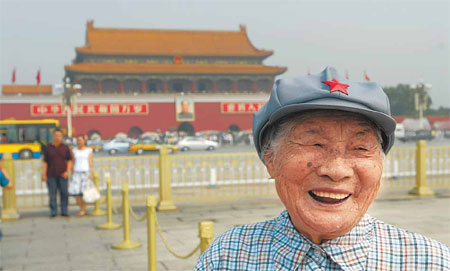Blood lines

She was born into an impoverished family in Bazhong county of Sichuan province, the youngest girl in a big family. Her life was a wretched one filled with famine, disease and abusive landlords.
One freezing winter's day, the 4-year-old Pu and her elder sister warmed themselves by a fire used for boiling salt in their landlord's yard. When the man discovered the sisters, he became furious and kicked them into the fire. Pu still has the burn scars to show.
 When Pu was 14, a group of guerilla soldiers set up camp in her hometown. They called themselves the "Workers' and Peasants' Red Army" that worked toward liberating poor people such as herself.
When Pu was 14, a group of guerilla soldiers set up camp in her hometown. They called themselves the "Workers' and Peasants' Red Army" that worked toward liberating poor people such as herself.
Pu was skeptical of them and warily watched those soldiers, who wore caps with red stars. But it was not long before she saw how differently they treated the poor from the landlords.
In September 1933, Pu joined the Fourth Army division of the Red Army and became a nurse. The following July, she became part of the Long March - a journey covering more than 10,000 km in 742 days.
During the March, Pu was suffering from a serious eye affliction at the foot of an over 4,000-m high mountain they had to climb in Sichuan. She could barely see anything but still insisted on taking care of Song Yimin, a seriously wounded commander.
With five other teenage nurses, Pu carried Song on a stretcher through hail and blizzards. They were exhausted but had to move on, because stopping meant they would freeze to death.
As they trudged up mountains, a raging thunderstorm struck and thick hail fell on them.
After the squall passed, they realized Song, whom they tried all means to save, had died.
Pu says she still remembers Song's final words: "You have finished your mission; head to our victory."
She kept those words close to her heart for the rest of the march, devoting herself to others across mountains and marshland.
In a ceremony held in Beijing last year to celebrate the 70th anniversary of the Long March, Pu, wearing a Red Army uniform, narrated her experience.
She said it taught her the meaning of dedication, a virtue that stays with her today.
"It is the soul of our nation; we should never forget the 200,000 soldiers who sacrificed their lives to fight for liberation," Pu says.
In the following War of Resistance against Japanese Aggression from 1937-45, Pu worked with her comrades in Yan'an, Shaanxi province.
In 1937, Pu joined the CPC and in 1939 married He Bingwen, a transportation officer in Yan'an. They had two daughters and five sons, all of whom became soldiers and members of the CPC.
After the founding of the People's Republic of China, Pu worked in the transportation department.
Her children and grandchildren continue her attitude toward life: "Life is enriched not by what you get, but by what you give."
Time line
1949
China has 44 registered national social organizations and thousands of regional ones.
1950s
The newly born PRC launches campaigns to reshuffle massive registered grassroots NGOs. Ultra-religious, feudal and reactionary ones are dismantled. NGO mafia and gangster groups are purged.
Early to mid-1960s
Social organizations prosper. By 1965, China has nearly 100 national social organizations and more than 6,000 local ones.
1966-76
All traditional forms of social organizations and NGOs are shut down, giving way to spontaneous "rebel" groups in the early years of the "cultural revolution". The "rebel" groups are later disbanded.
1978-1980s
NGOs bloom again as market reforms start.
1987
The central government extends cooperation with foreign NGOs.
1989
China has 4,446 NGOs.
1990s-2000s
The number of registered NGOs in China skyrockets to 266,600 by 2003. Experts say 3 million, 2 million of which are at the village level, is a more accurate estimate. More than 500 foreign NGOs were registered in China as of 2003.














